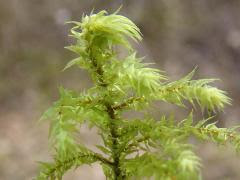 | |
| Electrified Cat-tail Moss |
 | |||||
| Calliergon cordifolium - heart-leaved spear moss Courtesy Koen Vandekerckhove |
 |
| Calliergon cordifolium Courtesy Michael Lüth |
In the world of bryology, only a handful of the 15,000* mosses have a common name, a few of which can be found at World of Mosses and Mosses, Lichens, and Liverworts of the Northwoods - Species Index.
Mosses are referred to by their Latin names at the genus and species level (a binomial). The bryologist or scientist who first describes the genus or species gets to names it. There are instances, as with Bryoandersonia illecebra, in which the person naming the moss honored someone, in this case bryologist Lewis Anderson, but had to "Latinize" his name to fit conventions.
Any abbreviation after the genus or species name, as in Mnium thomsonii Schimp., indicates the person who first described the moss, in this case Wilhelm Phillipe Schimper, a French bryologist and paleobotanist (1808-1880). If a name appears in parenthesis, it is because his or her choice of family or genus or even species convention has since been modified by other scientists.
Taxonomy is the science dealing with the description, identification, naming, and classification of organisms. There are a few biological classification systems, including:
- Linnean* — classified in a ranked hierarchy (list) based on structural similarities, developed before scientists understood that organisms evolved
- Evolutionary (or Darwinian) — grouped by how organisms are related through evolution and overall similarity
- Cladistic — grouped by an ancestor organism and all its descendents, as in a family tree of life
The USDA and the Natural Resources Conservation Service host a handy plant database where mosses are listed (classified) at every rank of the Linnean system. An example is Bryum caespiticium, or sidewalk moss.
- Kingdom Plantae – Plants
- Phylum (or Division) Bryophyta – Mosses
- Subdivision Musci
- Class Bryopsida – True mosses
- Subclass Bryidae
- Order Bryales
- Family Bryaceae
- Genus Bryum Hedw. – bryum moss
- Species Bryum caespiticium Hedw. – dry calcareous bryum moss
Kingdom, Phylum, Class, Order, Family, Genus, Species:
Kind Professors Can't Often Fail Good StudentsKing Phillip Came Over For George's Sake
Kings Play Chess on Fuzzy Green Squares
Keen Paleontologists Can Only Find Great Specimens
Kiss Pigs Carefully Or Face Grimy Smiles
Kids Picking Cacti On Fridays Get Stuck
Keep Peeling Cold Onions For Good Smells
Evolutionary and Cladistic Classification
 |
| Source: Wikipedia |
A cladogram is a diagram which shows ancestral relations between organisms (see below). Mosses are found in the plants clade.
| Source: Wikipedia |
| Carl von Linné, by Alexander Roslin, 1775. |
*Who was Carl Linneaus?
According to Wikipedia, Carl von Linné, later given the more Latin surname "Linnaeus," was a Swedish botanist, physician, and zoologist, who laid the foundations for the modern scheme of binomial nomenclature. He is known as the father of modern taxonomy, and is also considered one of the fathers of modern ecology.
*Counts vary, depending on the source, from 9,000 to 22,000.
_______
Read about the shrinking number of fungus and lichen taxonomists in the UK:
"The Fungus Among Us Multiplies As Mycological Taxonomists Wither" Wall Street Journal, September 7, 2011